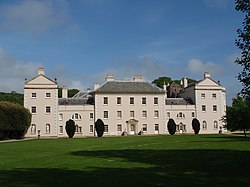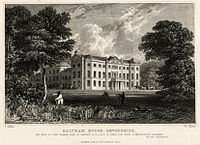Saltram House
| Saltram House | |
|
National Trust | |
|---|---|
 Saltram House | |
| Grid reference: | SX52045560 |
| Location: | 50°22’54"N, 4°4’57"W |
| Information | |
| Website: | Saltram |
Saltram House is a George II-era mansion house in the parish of Plympton, near Plymouth in south-western Devon. It was deemed by the architectural critic Nikolaus Pevsner to be "the most impressive country house in Devon".[1]
The house was designed by the architect Robert Adam, who altered and greatly expanded the original Tudor house on two occasions. The drawing room is considered one of Adam's finest interiors. Saltram is one of Britain's best preserved examples of an early Georgian house and retains much of its original decor, plasterwork and furnishings. It contains the Parker family's large collection of paintings, including several by Sir Joshua Reynolds (1723-1792), born and educated at Plympton and a friend of the Parker family.
The house today is Grade I listed.[2]
The present building was begun by John Parker (1703–1768)[3] of nearby Boringdon Hall, Plympton, and of Court House North Molton, both in Devon, together with his wife Catherine Poulett (1706-1758). It was completed by his son John Parker, 1st Baron Boringdon (1735-1788). His son was elevated to become the 1st Earl of Morley (1772-1840).
In 1957 Saltram House was donated by the Parker family to the National Trust in lieu of death duties, and is opened to the public.
Origins and early period
The name Saltram is apparently unconnected with the town of Saltram across the River Tamar from Plymouth in Cornwall, but may be of the same derivivation. The name is from the practice of salt harvesting in the nearby estuary, with ham, meaning 'homestead'. The first recorded family to have owned the manor is that of Mayhew, who owned Saltram for about 50 years.
In 1614, James Bagg (a member of Parliament for Plymouth from 1601–11 and Mayor of Plymouth) purchased Saltram in about 1614. His son, also James, served as a vice-admiral closely allied to the Duke of Buckingham, a favourite of King James I. He is believed twice to have embezzled funds from the Crown, the first occasion contributing to the failure of Buckingham's attack on Cadiz in 1625, though for some King Charles I twice defended him despite his seemingly obvious culpability. Affter his death, Saltram was described as comprising "One great mansion house, one stable, three gardens, two acres of orchard, eight acres of meadows". George Bagg supported the King in the Civil War and consequently Saltram suffered at the hands of the Parliamentarian forces. He retained the state only aftr paying Parliament a fine of £582.[4] It was neverthelsss confiscated by Parliament before 1660 and handed to the Parliamentarian captain Henry Hatsell in payment of a large debt owed by Bagg, though after the Restoration of the Monarchy in 1660 Hatsell was stripped of the house and estate, which were granted to Sir George Carteret in settlement of a loan he had made to the King during the Civil War.
In 1712 George Parker of Boringdon Hall, about two miles north of Saltram, purchased the manor. The Parker family held Saltram until 1951, when it was handed to the National Trust.
Development, embellishment and decline

John Parker inherited the house in 1743 and along with his wealthy wife, Lady Catherine Parker, (who largely funded the remodelling), clothed the building with symmetrical Palladian facades which cover the Tudor origins of the house. The interiors of the house were given delicate touches including Rococo ceiling plasterwork in the Entrance Hall, Morning Room and Velvet Drawing Room.[4]

John Parker the second, who was later created Lord Boringdon, succeeded his father in 1768 and a year later married Theresa Robinson. The Robinson family was of an artistic mind and advised on the embellishment of the house in the six years until Theresa's tragic early death. These six years are considered Saltram's golden age, epitomised by Joshua Reynolds' association with the house due to his close friendship with the family. The house owns ten portraits by Devon's greatest artist. Alongside Reynold's stands Robert Adam, who was approached by Lord Boringdon in 1768 to create a suite of neo-classical rooms along the east front which reaches its climax in the drawing room, perhaps the most iconic of all of Saltram House's rooms. Adam, who was the most fashionable architect and interior designer of the day, created everything from the door handles to the huge plasterwork ceiling. Not to be confined to the inside of the property, Boringdon also commissioned Nathaniel Richmond to lay out the present parkland which surrounds the house.[4]
The third John Parker, later known as Earl of Morley inherited the house just 20 years after his father and took longer again to make any major changes to the house. However, in 1819 he employed the Regency architect John Foulston to add the Entrance Porch and create the present Library out of two smaller rooms. His second wife, Frances, continued to develop the artistic legacy of the family by producing her own watercolours and Old Master copies which are on show in the house still. The Earl of Morley was ambitious and attempted to develop several industrial and engineering projects on the estate, but many of these were unsuccessful and the family fell heavily into debt.[4]

Money was so short that the third Earl of Morley was forced to leave the house between 1861 and 1884, and was only able to return after selling several of the estate's most valuable paintings. The family's fortunes picked up in 1926 when the 4th Earl of Morley inherited several other estates although the good times were short lived as the war brought damage from enemy bombing and eventually in 1951 the house and its contents were accepted in lieu of death duties by H.M. Treasury, which transferred them to the National Trust, which remains in charge to this day.[4]
Landscape

The silting up of the Laira means that once the view to the west was of a muddy estuary for all but the top of the tide, however recent tree growth has created a visually pleasing landscape. The in-filling of the Plymouth refuse dump at Chelson Meadow is now complete, creating green space.
Views of Plymouth Sound are possible from the first storey of the house and the castle folly in the gardens.
On film
- Sense and Sensibility (1995) used Saltram House as one of several local settings.[5]
Outside links
| ("Wikimedia Commons" has material about Saltram House) |
- Saltram - information at the National Trust]
References
- ↑ Nikolaus Pevsner: The Buildings of England: Devon, 1952; 1989 Penguin Books ISBN 978-0-300-09596-8page 710
- ↑ Saltram House - British Listed Buildings
- ↑ Vivian, Lt.Col. J.L., (Ed.) The Visitations of the County of Devon: Comprising the Heralds' Visitations of 1531, 1564 & 1620, Exeter, 1895, p.588, pedigree of Parker
- ↑ 4.0 4.1 4.2 4.3 4.4 Johnson, Ceri: 'Saltram' (National Trust, Press, 1998)
- ↑ Parrill, Sue (2002). Jane Austen on film and television: a critical study of the adaptations. Jefferson, North Carolina: McFarland & Company, Inc., Publishers. p. 6. ISBN 0-7864-1349-2. https://books.google.com/books?id=l6dsN6KfXUkC&printsec=frontcover&dq=sense+and+sensibility+1995+film#v=onepage&q=sense%20and%20sensibility&f=false.
